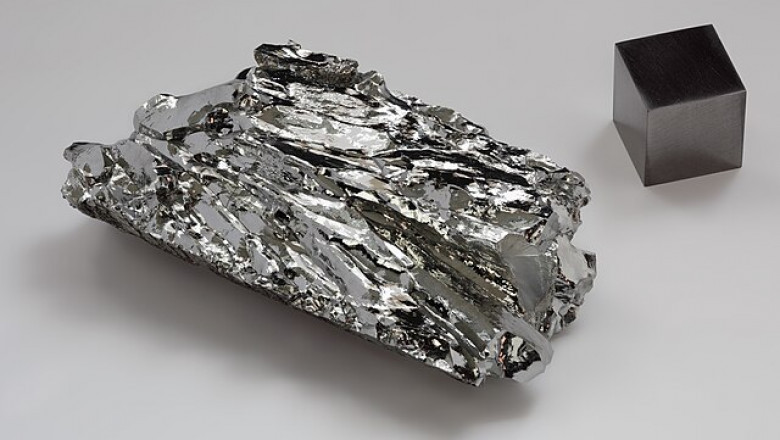views
Molybdenum is a steel gray metal that is quite durable and has a high melting point. It was first discovered in 1778 by Carl Wilhelm Scheele in Sweden who identified it in the mineral molybdenite. However, it was not until the early 20th century that its properties began to be seriously investigated which led to new discoveries of its industrial applications.
Physical and Chemical Properties of Molybdenum
Molybdenum has an atomic number of 42 and is in group 6 of the periodic table along with chromium and tungsten. Its atomic weight is 95.95. Some key physical properties include having a melting point of 2,623°C which is the sixth highest of any metal. It has a density of 10.2 grams per cubic centimeter. Chemically, molybdenum is quite stable and resistant to corrosion from acids, bases and oxidizing agents. However, it will slowly dissolve and corrode in nitric acid.
Industrial Uses of Molybdenum as an Alloying Element
One of the most important uses of molybdenum is as an alloying agent for steel. Adding a small amount between 0.15-2% molybdenum to steel increases its strength, hardness and temperature resistance without significantly impacting the steel's toughness. Molybdenum allows steel to retain strength at higher temperatures which makes it useful for applications like pipelines and pressure vessels. It also improves hardenability which permits deep hardening of steel machine parts. Molybdenum alloy steels with 0.5% content have over 50% higher yield strength than plain carbon steels.
Use in Stainless Steels
Stainless steels used in applications like kitchen appliances, cutlery and hardware contain between 2-3% molybdenum. Its inclusion improves corrosion resistance against chlorides and organic acids. The stabilized austenitic stainless steels have both chromium and molybdenum as major alloying elements which give them excellent formability and polishability along with rust resistance. These types of stainless steels like 18/8 and 18/10 are commonly used for architectural applications and pressure vessels.
Applications in High Temperature Processes
Due to its high temperature strength and oxidation resistance up to 900°C, molybdenum is used as a heating element in furnaces, heaters, lighting fixtures, electric irons and other heating appliances. It forms an inert barrier of molybdenum dioxide at high temperatures that protects the metal from further oxidation. Molybdenum's thermal robustness has led to uses like combustion engine valves and turbocharger rotors as well as furnace components. In aerospace and defense, molybdenum finds applications in rocket engines and hypersonic aircraft skins due to its high temperature capabilities.
Catalytic Functions of Molybdenum Compounds
Molybdenum forms stable and versatile compounds with oxides, sulfides and complex ions that are useful catalysts in industrial applications. Ammonium molybdate is employed as a catalyst in oil refineries to remove sulfur from fuels during the hydrodesulphurization process. Sulfide and oxide catalysts improve activity for converting heavy hydrocarbon feeds into gasolines and other fuels. Molybdenum cofactor is essential for bacterial fixation of nitrogen from the atmosphere into compounds useful for agriculture. Its various oxidation states from Mo(0) to Mo(VI) allow more flexible catalytic roles than other transition metals.
Use in Electronics
The electrical and thermal conductivity of molybdenum has led to important applications in electronics manufacturing. Molybdenum forms silicides that are used in integrated circuits to create low resistance contacts to silicon semiconductor devices. Thin film coatings improve solderability and prevent leaching in circuit boards. Molybdenum is a component of fuse elements in cars and appliances because it has high resistivity and melts at predictable temperatures for overcurrent protection. Its non-magnetic properties are advantageous for high precision applications like gimbals.
Molybdenum in Agriculture and Consumer Products
Molybdenum is essential in very small amounts as a micronutrient for plant and animal life. It functions as a cofactor for several important enzymes involved in nitrogen fixation and utilization. Molybdenum fertilizers increase crop yields of soybeans, lentils and cauliflower growing in molybdenum deficient soils. Dietary supplements containing molybdenum are marketed to promote bone and joint health in humans since it is required in trace amounts. Molybdenum steel alloys are also used to produce machinist's tools, industrial knives, saw blades and drill bits due to their high toughness and wear resistance.
Recent Developments and Outlook
Research is ongoing to develop new molybdenum-based catalysts for synthesizing biodiesel from waste vegetable oils. As demand grows for alternative fuel sources, molybdenum's catalytic properties will continue assisting refineries. New stainless steel formulations are increasing the amount of molybdenum to over 3% for enhanced corrosion resistance in harsh environments like desalination plants. With its many useful metallurgical and chemical attributes, molybdenum use will likely expand in the fast growing energy, transportation and infrastructure sectors in the coming decades. It remains an important industrial metal centuries after its initial discovery.
Get this Report in Japanese Language:
Get this Report in Korean Language:
About Author:
Alice Mutum is a seasoned senior content editor at Coherent Market Insights, leveraging extensive expertise gained from her previous role as a content writer. With seven years in content development, Alice masterfully employs SEO best practices and cutting-edge digital marketing strategies to craft high-ranking, impactful content. As an editor, she meticulously ensures flawless grammar and punctuation, precise data accuracy, and perfect alignment with audience needs in every research report. Alice's dedication to excellence and her strategic approach to content make her an invaluable asset in the world of market insights.
(LinkedIn: www.linkedin.com/in/alice-mutum-3b247b137 )






















Comments
0 comment